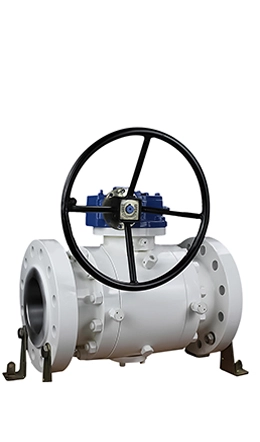The KFTE Trunnion Ball Valve is the ball valve of choice for larger sizes and higher pressure applications, particularly in pipelines and critical process systems. These valves incorporate advanced design features, including a built-in cavity relief mechanism, anti-static capability, and an intrinsic double block and bleed function. Additionally, all KFTE Trunnion Ball Valves undergo fire-safe testing in compliance with API 607/API 6FA standards.


Trunnion ball valves excel in high-pressure, high-reliability applications due to their fixed ball design, robust sealing, and low torque operation. Their versatility in actuation, maintenance-friendly design, and compliance with stringent safety standards make them a preferred choice in critical industrial systems.
1. Design and Construction:
Trunnion-Mounted Ball: The ball is fixed and supported by upper and lower trunnions (shafts), providing stability and reducing mechanical stress.
Fixed Ball Design: The ball does not displace under pressure, unlike floating ball valves, ensuring consistent alignment.
Seat Mechanism: Spring-loaded or pressure-energized seats maintain contact with the ball, enhancing sealing reliability.
2. Pressure Handling:
High-Pressure Suitability: Ideal for applications exceeding Class 600 ratings. Trunnions absorb thrust from line pressure, minimizing seat deformation.
Bidirectional Pressure Resistance: Capable of sealing against pressure from either direction due to robust seat design.
3. Safety Features:
Fire-Safe Design: Secondary metal seats and graphite seals prevent leakage during fire exposure (API 607/6FA compliant).
Anti-Static Device: Prevents spark risk from static buildup.
Blow-Out Proof Stem: Ensures stem integrity under high pressure.
1. Ball Support Mechanism
Trunnion Ball Valve:
The ball is fixed and supported by upper and lower trunnions (shafts).
The ball does not move under pressure; trunnions absorb mechanical and hydraulic forces.
Floating Ball Valve:
The ball is not anchored and “floats” between the seats.
Line pressure pushes the ball against the downstream seat to create a seal.
2. Pressure Handling
Trunnion Ball Valve:
High-pressure applications (Class 600 and above).
Trunnions prevent seat deformation by absorbing thrust from the line pressure.
Suitable for bidirectional sealing (pressure from either direction).
Floating Ball Valve:
Low to moderate pressure (up to Class 300 typically).
Relies on line pressure to force the ball against the seat, limiting effectiveness at very high pressures.
Generally unidirectional sealing (seals against pressure from one direction).
Sealing Mechanism
Trunnion Ball Valve:
Uses spring-loaded or pressure-energized seats to maintain contact with the ball.
Sealing is active even at zero pressure due to pre-loaded seats.
Often uses dual-sealing systems (e.g., soft + metal seats) for fire-safe compliance.
Floating Ball Valve:
Sealing depends on line pressure pushing the ball against the seat.
At low or no pressure, sealing may weaken.
Typically uses soft seats (e.g., PTFE) for tight shut-off.
